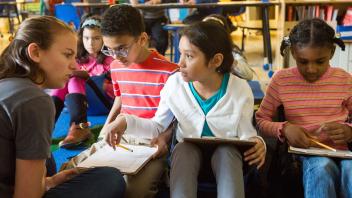What is the directed reading thinking activity?
DRTA is a comprehension strategy that guides students in asking questions about a text, making predictions, and then reading to confirm or refute their predictions. The DRTA process encourages students to be active and thoughtful readers, enhancing their comprehension.
Why use DRTA?
- It encourages students to be active and thoughtful readers.
- It activates students’ prior knowledge.
- It teaches students to monitor their understanding of the text as they’re reading.
- It helps strengthen reading and critical thinking skills.
- The activity can be easily adapted for a variety of texts and across disciplines.
Key Information
Focus
When To Use This Strategy
Appropriate Group Size
How to use DRTA
Here are the steps for using the directed reading thinking activity in your classroom:
- Determine the text to be used and pre-select points for students to pause during the reading process.
Introduce the text, the purpose of the DRTA, and provide examples of how to make predictions.
Note: Be aware of the reading levels of each student, and be prepared to provide appropriate questions, prompts, and support as needed.
- Use the following outline to guide the procedure:
D = Direct
Activate your students’ thinking prior to reading a passage by scanning the title, chapter headings, illustrations, and other materials. Use open-ended questions to direct students as they make predictions about the content or perspective of the text (e.g., “Given this title, what do you think the passage will be about?”).
R = Reading
Students read up to the first pre-selected stopping point. You then prompt your students with questions about specific information and ask them to evaluate their predictions and refine them if necessary. This process should be continued until students have read each section of the passage.
T = Thinking
At the end of each section, students go back through the text and think about their predictions. Students should verify or modify their predictions by finding supporting statements in the text. You can ask questions such as:
- What do you think about your predictions now?
- What did you find in the text to prove your predictions?
- What did you we read in the text that made you change your predictions?
Watch a lesson on making predictions about a text (whole class)
During the reading of a story, the teacher has the students make predictions as to what they think will happen next. The students make adjustments to their predictions as the story is told. (Teach for Life)
Collect resources
Download blank template
Examples
- Use a DRTA with the children’s book Dear Mr. Blueberry. See example ›
- Use a DRTA with the children’s book Cloudy with a Chance of Meatballs. See example ›
- Use a DRTA with the children’s book David Goes to School. See example ›
Differentiate instruction
For second language learners, students of varying reading skill, and younger learners
- The reading should be broken into small sections so that your students have time to think about and process information.
- The amount of reading should be adjusted to fit the purpose and the difficulty of the text.
- Writing may be included as part of the DRTA. As your students become more comfortable with this strategy, have each student write predictions in a learning log or on a piece of paper. Then, in small groups, they can discuss their predictions and share their thinking processes. Finally, ask your students to write summary statements about how their predictions compared to the passage.
See the research that supports this strategy
Jennings, C. & Shepherd, J. (1998). Literacy and the key learning areas: successful classroom strategies. Eleanor Curtain Publishing.
McKenna, M. & Robinson, R. (2002). Teaching through text: Reading and writing in the content areas (3rd ed.). Boston: Allyn and Bacon.
Murdoch, K. (1998). Classroom Connections: Strategies for Integrated Learning. Eleanor Curtain Publishing.
Stauffer, R. G. (1969). Directing reading maturity as a cognitive process. New York: Harper & Row.
